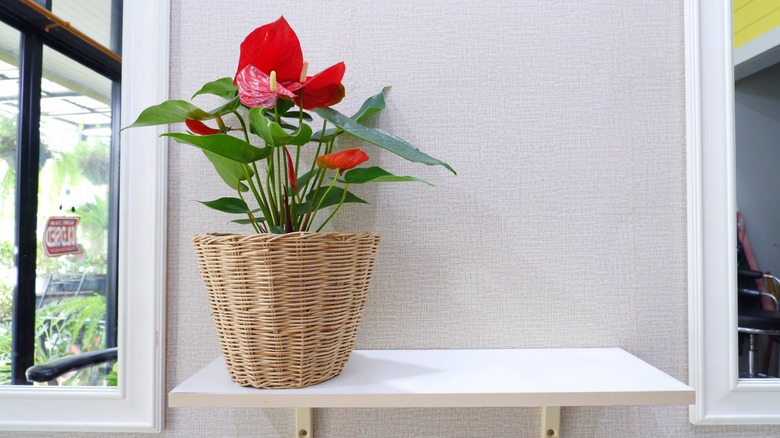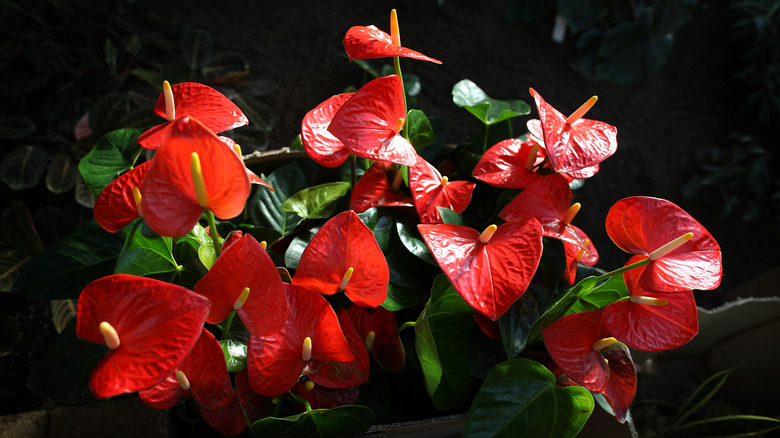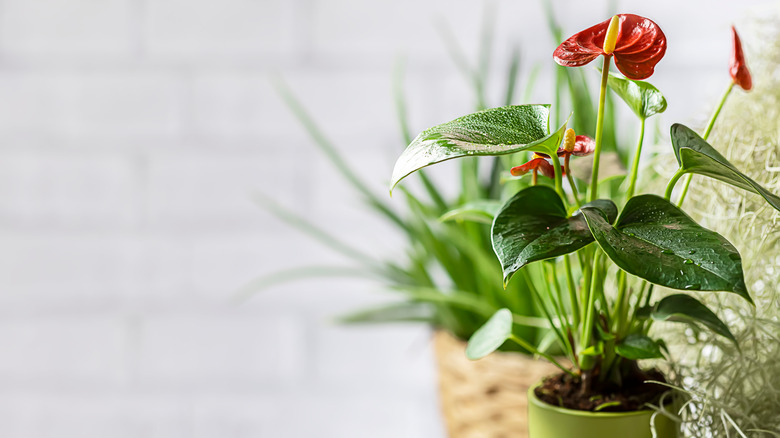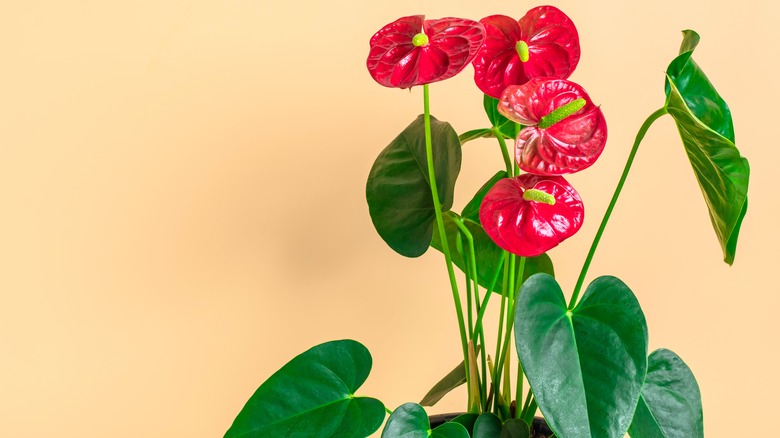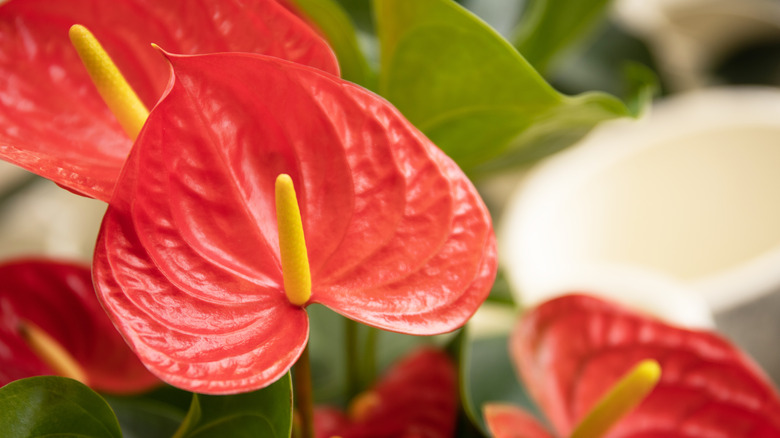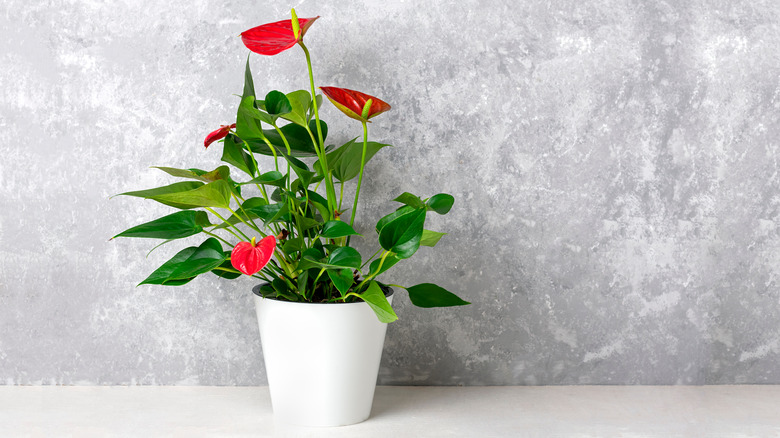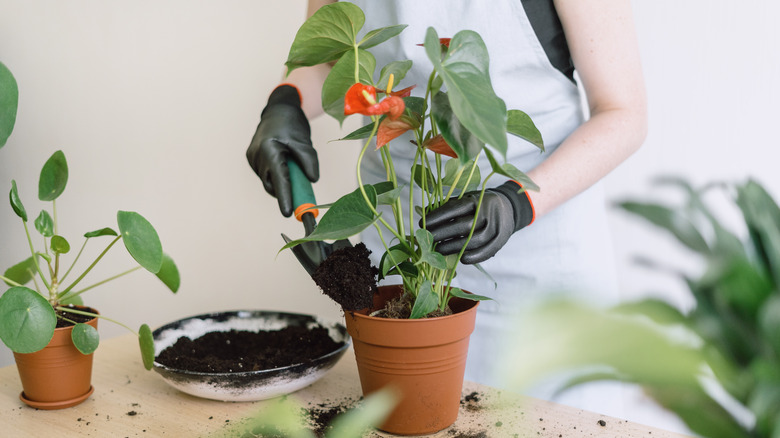How To Properly Care For Your Anthurium
Anthurium, also known as flamingo flower, laceleaf, and tailflower, refers to a genus of flowering plants that are native to Central and South America, as well as the Caribbean, per The Spruce. These perennial plants bloom year-round, making them a popular choice amongst blooming houseplant enthusiasts. In warmer, tropical climates, anthuriums can also be grown outside. Identifiable by their waxy, heart shaped leaves and brightly colored flowers, including shades of red, pink, and white, anthuriums can be fussy and a little high maintenance, but their near-constant blooms prove to be an excellent reward for your hard work.
According to Bloomscape, the name anthurium comes from the Greek words anthos and oura, which together translate to tall flower. Anthuriums not only stun with their brightly colored blooms, but they also produce a long, yellow-green stalk from the center of their flower. This plant is also known as a symbol of hospitality. Read on to learn more about how to care for these bold houseplants, and sustain them as a feature in your home.
How to use anthurium in garden
Anthurium can be grown outdoors in a garden starting in USDA zone 10, according to Gardening Know How, including southern California, southern Florida, and Hawaii. They cannot thrive in temperatures lower than 60 degrees, and will do best in high humidity, preferably 70%. Many people living in colder climates opt to bring their potted anthuriums outside during the summer — just be careful that nighttime temperatures don't get too cold for the plant, or it could be damaged.
Outdoor anthuriums, whether potted or planted in the ground, will do best in partially shaded conditions. Most importantly, they should not be exposed to direct sun, as it will damage the leaves. They grow in tropical forests under dense canopies, which you should aim to replicate. The Healthy Houseplant suggests planting or putting potted anthuriums under large shade trees or other plants with heavy foliage. Not only will the plants provide ideal light conditions, but old leaves and branches that fall into the soil will decay and help feed the anthurium. They need well draining soil, and enjoy drying out between waterings to prevent root rot. Consider mulching around the plant to help it retain ideal moisture levels.
Anthuriums are not tolerant of wind, which should be considered when planting or placing them outside. They are also toxic to ingest or touch, so place them away from easily accessible areas to prevent animals or children from getting to them.
How to grow anthurium
An easy way to get more anthurium plants is via propagation. This is a relatively easy (but slow) process, as anthuriums grow aerial roots along the stem of the plants — meaning you can begin propagation with pre-grown roots. Per The Healthy Houseplant, anthuriums can only be propagated by stem cuttings, but can grow roots in both soil and water. To get a cutting, look for a leaf that has at least two nodes. Nodes are the little bumps along stems where new leaves grow. Simply snip off the cutting at the surface of the soil with clean shears. Peel off any stipules — the brown, snakeskin-like material that protects growing leaves. Also remove any flowers, as the anthurium will spend more time providing nutrients to the flower than growing new roots and stems.
If propagating in a pot, grab a starter nursery pot and fill with a well draining potting mix. Consider using orchid mix to promote blooms. Dip the end of the cutting in rooting hormone, add to the dirt, and water. If there are aerial roots, make sure they are under the dirt. If there are only nodes, bury as many as possible, at least one. Cover in plastic wrap to promote humidity, and expect new growth in five to six weeks.
To propagate in water, fill a glass with water and add the cutting. Consider adding liquid rooting hormone. When the roots have grown 1 to 2 inches long, repot in soil.
How to care for anthurium
Most tropical houseplants have a very specific, unwavering set of care needs, and anthuriums are no different. While they are not particularly difficult needs to meet, they are strict, and should be vigilantly adhered to. Even with all of its requirements met, anthuriums can still be a little troublesome — take these as base rules, but feel free to play around with your plant's specific wants to see if different lighting conditions, humidity levels, etc. encourage more growth.
Anthuriums naturally grow under the canopies of trees, and as such, prefer more shaded light conditions, per Bloomscape. Bright, indirect light is ideal. Consider placing anthurium by a north facing window, and avoid south facing windows, as they let in direct sun rays. East and west windows are fine, as long as the plant is not in the path of direct sun. Let the plant dry out almost completely between watering, and then water heavily and let drain completely.
Anthuriums require lots of humidity. Daily misting is a good way to achieve this, as is placing the plant near a humidifier or on a pebble tray. Avoid placing the plant near air conditioners, vents, or fans. Feed monthly in the spring and summer with a liquid fertilizer — consider using a blooming fertilizer, although regular houseplant fertilizer is fine. Remove any dying flowers and leaves to promote constant new growth.
Varieties of anthurium
There are over 1,000 varieties of anthurium, according to Happy Sprout. They all come in an array of shapes, sizes, and colors, with some varieties producing bright pink and red flowers, some rich with green foliage, and some sporting darker blooms. Here are just a few of those varieties, per Leafy Place:
-
Anthurium Scherzerianum: Also called the pig's tail anthurium, this variety gets its nickname from the curly pink spadix that emerges from its pink-red blooms.
-
Anthurium Watermaliense: This variety is commonly called the black anthurium due to its strikingly dark spathes, though the flower is actually a very dark, rich shade of purple.
-
Anthurium Forgetii: Native to Columbia, this variety sports large, dark green leaves with white variegation, and produces yellow and orange flowers, sometimes growing purple berries.
-
Anthurium Hookeri: Bird's nest anthurium, as it's commonly known, is identifiable by its large, dramatic leaves, which produces dark purple spadices when mature.
-
Anthurium Scandens: Known most commonly as pearl laceleaf, this climbing variety gets its name from the white berries that grow along its spadices that resemble pearls.
Is anthurium toxic?
Anthurium is toxic, according to the ASPCA. The plant has insoluble calcium oxalate crystals, says Pet Poison Helpline, which when ingested by pets will go to the gastrointestinal system and irritate the ingestion site — resulting in oral swelling and irritation, drooling, vomiting, and difficulty swallowing. The difficulty swallowing can lead to restriction of the airways. If you suspect your pet has consumed anthurium, call the vet immediately. If you catch your pet eating the plant, induce vomiting, then call the vet.
Anthurium is also toxic to humans. According to Boston Parents Paper, ingestion of the plant can result in irritation to your mouth, oral blisters and swelling, and a burning sensation, as well as difficulty breathing and swallowing. Symptoms can be combated with cold medicine, over the counter pain medications, and even licorice. Call a poison hotline if symptoms persist.
Anthurium also produces a sap that is poisonous to touch, per Garden.eco. When the sap comes in contact with skin, it can cause severe itching, burning, and irritation. Wear gloves when handling the plant, and wash your hands afterwards.
How to repot anthurium
According to The Spruce, you should repot your anthurium every two years. A good sign it's time to repot is if the aerial roots have overtaken the pot. Additionally, the pot you replant the anthurium in is important. First, make sure it is at least 2 inches larger than the previous pot to make room for new growth. If you tend to neglect plants, consider getting a ceramic or plastic pot to help retain water, though terracotta pots will encourage drainage and are ideal for the plant. Anthuriums prefer a coarse soil mixture. Consider using an orchid soil mix as the base, and adding sand and peat moss.
Wear gloves when replanting to avoid skin irritation. Begin by removing the anthurium from its current part. Assess the root system, and remove any rotten or unhealthy roots. Remove as much old dirt as possible. Add your soil to the new pot, about 1/3 of the way up. Add your anthurium, and make sure it's roughly at the same elevation as it was previously. Fill with soil, water to expose air pockets, and water again, letting it drain completely. Ensure the plant gets plenty of humidity and TLC in subsequent weeks to help it acclimate to its new home.
